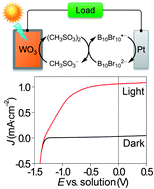Photoelectrochemical oxidation of anions by WO3 in aqueous and nonaqueous electrolytes†
Abstract
The behavior of WO3 photoanodes has been investigated in contact with a combination of four anions (Cl−, CH3SO3−, HSO4−, and ClO4−) and three

* Corresponding authors
a
Beckman Institute and Kavli Nanoscience Institute, Division of Chemistry and Chemical Engineering, California Institute of Technology, M/C 127-72, 1200 E. California Blvd., Pasadena, CA 91125, USA
E-mail:
hbgray@caltech.edu, nslewis@caltech.edu
The behavior of WO3 photoanodes has been investigated in contact with a combination of four anions (Cl−, CH3SO3−, HSO4−, and ClO4−) and three

 Please wait while we load your content...
Something went wrong. Try again?
Please wait while we load your content...
Something went wrong. Try again?
Q. Mi, R. H. Coridan, B. S. Brunschwig, H. B. Gray and N. S. Lewis, Energy Environ. Sci., 2013, 6, 2646 DOI: 10.1039/C3EE40712H
To request permission to reproduce material from this article, please go to the Copyright Clearance Center request page.
If you are an author contributing to an RSC publication, you do not need to request permission provided correct acknowledgement is given.
If you are the author of this article, you do not need to request permission to reproduce figures and diagrams provided correct acknowledgement is given. If you want to reproduce the whole article in a third-party publication (excluding your thesis/dissertation for which permission is not required) please go to the Copyright Clearance Center request page.
Read more about how to correctly acknowledge RSC content.
 Fetching data from CrossRef.
Fetching data from CrossRef.
This may take some time to load.
Loading related content
